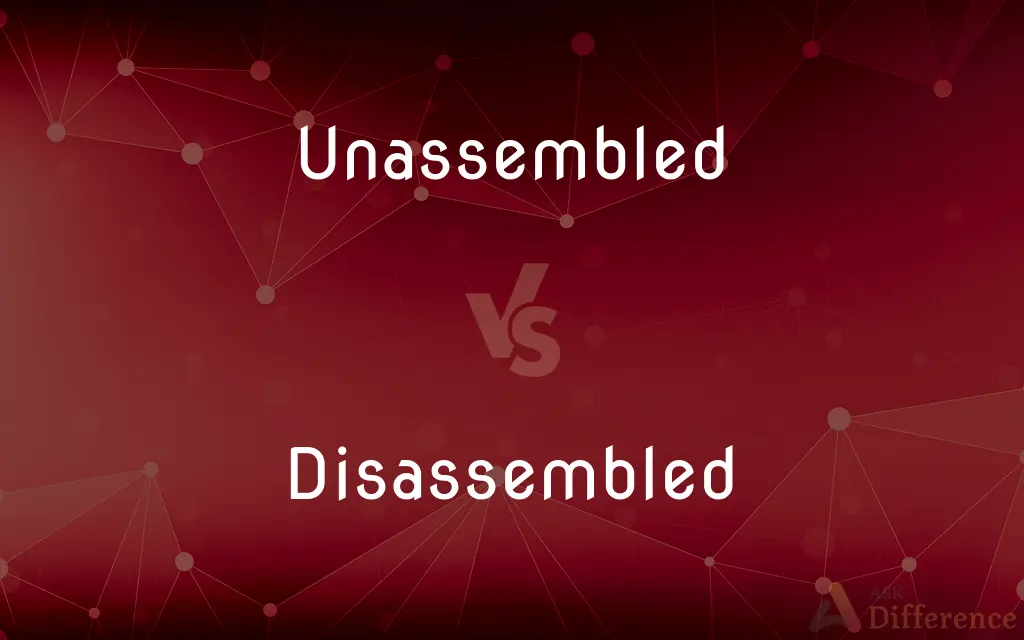Unassembled vs. Disassembled — What's the Difference?
By Maham Liaqat & Urooj Arif — Updated on April 2, 2024
Unassembled refers to items not put together or constructed, typically shipped in pieces for later assembly. Disassembled means an item was fully constructed but then taken apart into pieces.

Difference Between Unassembled and Disassembled
Table of Contents
ADVERTISEMENT
Key Differences
Unassembled items have never been put together; they are often sold in a state requiring assembly by the consumer or a professional. This is common with furniture, toys, and some electronic devices, where shipping in pieces reduces costs and packaging size. Disassembled items, on the other hand, were once whole but have been taken apart. This could be for reasons such as repair, maintenance, relocation, or storage. The key difference lies in the item's history: unassembled items have not yet been assembled, whereas disassembled items have been taken apart after assembly.
When purchasing an unassembled product, the expectation is that all the necessary components for assembly will be included, often with instructions. This can be seen as an advantage, as it ensures that the buyer receives everything needed for a new, intact product. In contrast, disassembled items might be missing parts or instructions, especially if the disassembly was not done systematically or parts were lost over time.
The process of assembly versus disassembly can also differ significantly. Unassembled products are designed with the end-user's assembly in mind, often simplified to ensure that assembly is possible with minimal tools or expertise. Disassembled products might not come with the convenience of easy reassembly, as they were not necessarily designed to be taken apart and put back together multiple times or by a layperson.
For businesses and manufacturers, selling unassembled products can save on shipping and storage costs, as products take up less space when unassembled. This is less relevant for disassembled items, which are typically not in a new, sellable state but might be in transition, such as moving to a new location or undergoing cleaning or repairs.
The consumer experience is notably different. Unassembled products come with the anticipation (and sometimes the dread) of assembly, offering a fresh start but requiring effort and time. Disassembled items, while they might come with the satisfaction of repair or the efficiency of storage, involve the challenge of keeping track of all components and correctly reassembling them.
ADVERTISEMENT
Comparison Chart
State Upon Purchase
Never assembled, requires assembly
Previously assembled, now in pieces
Purpose
Sold for assembly by the end user or a professional
Taken apart for repair, maintenance, or storage
Assembly Instructions
Typically included
May not be included
Parts and Components
Usually all included and new
Parts may be missing or worn
Consumer Experience
Requires assembly, often seen as a DIY project
Involves reassembling, may require expertise
Shipping and Storage
More efficient, reduces costs
Not typically relevant for consumer products
Designed for Reassembly
Yes, intended for initial assembly
Not necessarily, could be complex to reassemble
Compare with Definitions
Unassembled
Requires putting together before use.
Many children's toys come unassembled to save packaging space.
Disassembled
Taken apart from a whole.
The disassembled engine lay in pieces for cleaning.
Unassembled
Sold in parts for later assembly.
The bookshelf arrives unassembled, with all screws and panels in the box.
Disassembled
Previously assembled but now in parts.
After moving, the disassembled desk needed to be put back together.
Unassembled
Designed for end-user assembly.
Flat-pack furniture is unassembled for easy transport.
Disassembled
Components may be missing.
The disassembled antique clock was missing a gear.
Unassembled
Components and instructions included.
The unassembled computer kit includes detailed assembly instructions.
Disassembled
Not necessarily designed for easy reassembly.
Disassembling electronic devices can lead to reassembly challenges.
Unassembled
Not yet constructed or built.
The unassembled drone kit allows for customization during assembly.
Disassembled
Often for repair or maintenance.
The bicycle was disassembled for a thorough tune-up.
Unassembled
Made or manufactured with parts or sections ready to be joined or fitted together before use
Unassembled metal shelving.
Disassembled
To take apart
Disassemble a toaster.
Unassembled
Not assembled.
Disassembled
To come apart
The unit disassembles easily.
Disassembled
To break up in random fashion
The spectators began to disassemble.
Disassembled
Simple past tense and past participle of disassemble
Common Curiosities
Is it common for disassembled items to lose parts?
Yes, it's common for parts to be lost during disassembly, especially if not carefully documented or stored.
Do unassembled items always come with instructions?
Most unassembled items include instructions, but the clarity and quality can vary greatly.
Can disassembling an item void its warranty?
Yes, disassembling a product can void its warranty, especially if not done by a professional or as instructed by the manufacturer.
Can unassembled items be easier to transport?
Yes, unassembled items are often easier and cheaper to transport because they take up less space and can be packaged more efficiently.
Are tools required for assembling unassembled products?
Often, basic tools are required, though some items are designed to be assembled without any tools.
Why would someone choose an unassembled product?
For the cost savings on purchase and shipping, the enjoyment of DIY assembly, or the ability to customize during assembly.
What are the risks of buying disassembled items second-hand?
The main risks include missing parts, lack of instructions, and potential damage or wear to the components.
Is reassembling a disassembled item always possible?
Reassembling is possible if all parts are intact and the person has the necessary skills or instructions, but it can be more challenging than assembling an unassembled product.
How does the difficulty level of assembly compare between unassembled and disassembled items?
Unassembled items are typically designed for consumer assembly and come with instructions, making them generally easier to assemble than disassembled items, which may not have clear reassembly guidance.
Are there resources available to help with assembling unassembled products?
Yes, many manufacturers provide online resources such as instructional videos, detailed guides, and customer support hotlines to assist with assembly.
What precautions should I take when disassembling electronic devices?
Ensure the device is powered off and unplugged. Use the appropriate tools, and be mindful of sensitive components and static discharge.
How can disassembling products be beneficial for the environment?
Disassembling allows for easier recycling and repurposing of parts, reducing waste and the need for new materials.
Is it easier to transport unassembled or disassembled products?
Unassembled products are usually easier to transport since they come in manufacturer-designed packaging, while disassembled products may lack compact packaging.
Can I customize unassembled products during assembly?
Yes, unassembled products offer an opportunity for customization, such as painting or modifying parts before assembly.
Share Your Discovery

Previous Comparison
Sharp vs. Smart
Next Comparison
Dampening vs. DampingAuthor Spotlight
Written by
Maham LiaqatCo-written by
Urooj ArifUrooj is a skilled content writer at Ask Difference, known for her exceptional ability to simplify complex topics into engaging and informative content. With a passion for research and a flair for clear, concise writing, she consistently delivers articles that resonate with our diverse audience.
















































